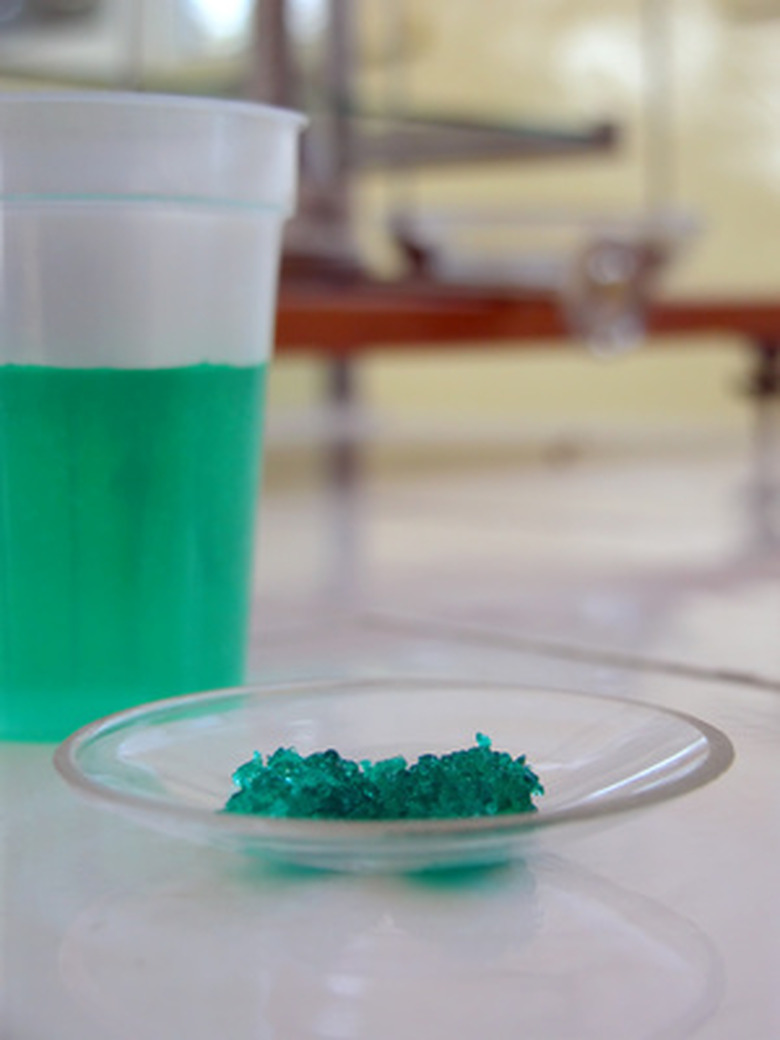How To Calculate PH Of Buffer Solutions
A buffer is an aqueous solution designed to maintain a constant pH, even when exposed to small amounts of acids or bases. Whether acidic (pH < 7) or basic (pH > 7), a buffer solution consists of a weak acid or base mixed with the salt of its conjugate base or acid, respectively. To calculate the specific pH of a given buffer, you need to use the Henderson-Hasselbalch equation for acidic buffers: "pH = pKa + log10([A-]/[HA])," where Ka is the "dissociation constant" for the weak acid, [A-] is the concentration of conjugate base and [HA] is the concentration of the weak acid.
For basic (a.k.a. alkaline) buffers, the Henderson-Hasselbach equation is "pH = 14 – (pKb + log10([B+]/[BOH]))," where Kb is the "dissociation constant" for the weak base, [B+] is the concentration of conjugate acid and [BOH] is the concentration of the weak base.
Calculate the pH for Acidic Buffer Solutions
Step 1
Multiply the volume (in liters) of the weak acid by its concentration (in moles/liter). This gives you the total number of acid molecules that will be in the final buffer solution.
Step 2
Use the scale to weigh the conjugate base salt that you will use to create the buffer. Record the mass in grams.
Step 3
Divide this mass by the molar weight (in grams per mole) of the salt to determine the total number of moles the sample contains.
Step 4
Look up the dissociation constant (Ka) for the weak acid. See the Resources section below for a link to an extensive list of Ka values.
Step 5
Add the volume of the weak acid (in liters) to the volume of the water in which you plan to dissolve the conjugate base salt (in liters). This value represents the final volume of the buffer solution.
Step 6
Divide the number of moles of weak acid molecule (from Step 1) by the total volume of the buffer solution (from Step 5). This gives you [HA], the concentration of the weak acid in the buffer.
Step 7
Divide the number of moles of conjugate base salt molecules (from Step 3) by the total volume of the buffer solution (from Step 5). This gives you [A-], the concentration of the conjugate base in the buffer.
Step 8
Use your calculator to determine the standard logarithm (i.e., log 10) of the weak acid's dissociation constant (from Step 4). Multiply the result by -1 to get the value of "pKa."
Step 9
Divide the value of [A-] (from Step 7) by the value of [HA] (from Step 6).
Step 10
Use your calculator to determine the standard logarithm of the result from Step 9.
Step 11
Add together the results from Steps 8 and 10 to calculate the pH of the buffer solution.
Calculate the pH for Basic (Alkaline) Buffer Solutions
Step 1
Multiply the volume (in liters) of the weak base by its concentration (in moles/liter). This gives you the total number of base molecules that will be in the final buffer solution.
Step 2
Use the scale to weigh the conjugate acid salt that you will use to create the buffer. Record the mass in grams.
Step 3
Divide this mass by the molar weight (in grams per mole) of the salt to determine the total number of moles the sample contains.
Step 4
Look up the dissociation constant (Kb) for the weak base. See the Resources section below for a link to an extensive list of Kb values.
Step 5
Add the volume of the weak base (in liters) to the volume of the water in which you plan to dissolve the conjugate acid salt (in liters). This value represents the final volume of the buffer solution.
Step 6
Divide the number of moles of weak base molecule (from Section 2, Step 1) by the total volume of the buffer solution (from Section 2, Step 5). This gives you [BOH], the concentration of the weak base in the buffer.
Step 7
Divide the number of moles of conjugate acid salt molecules (from Section 2, Step 3) by the total volume of the buffer solution (from Section 2, Step 5). This gives you [B+], the concentration of the conjugate acid in the buffer.
Step 8
Use your calculator to determine the standard logarithm (i.e., log 10) of the weak base's dissociation constant (from Section 2, Step 4). Multiply the result by -1 to get the value of "pKb."
Step 9
Divide the value of [B+] (from Section 2, Step 7) by the value of [BOH] (from Section 2, Step 6).
Step 10
Use your calculator to determine the standard logarithm of the result from Section 2, Step 9.
Step 11
Add together the results from Steps 8 and 10 to calculate the pOH of the buffer solution.
Step 12
Subtract the pOH from 14 to determine the pH of the buffer solution.
Things Needed
- Digital scale
- Graphing calculator
Cite This Article
MLA
Pasquesi, Andy. "How To Calculate PH Of Buffer Solutions" sciencing.com, https://www.sciencing.com/calculate-ph-buffer-solutions-5976293/. 13 March 2018.
APA
Pasquesi, Andy. (2018, March 13). How To Calculate PH Of Buffer Solutions. sciencing.com. Retrieved from https://www.sciencing.com/calculate-ph-buffer-solutions-5976293/
Chicago
Pasquesi, Andy. How To Calculate PH Of Buffer Solutions last modified March 24, 2022. https://www.sciencing.com/calculate-ph-buffer-solutions-5976293/
